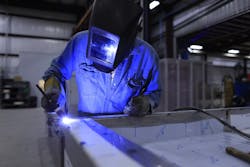The inherent sustainability of steel
When considering the sustainability of metal building systems, attention is often paid to the low-waste factory manufacturing, and the excellent energy performance of the building. However, a significant factor is frequently overlooked: the inherent recycled content of steel.
Most commercially available steel is made by one of two processes, either the Basic Oxygen Furnace (BOF), or the Electric Arc Furnace (EAF). These are the two steel-making systems that vastly expanded steel production after World War II, and continue to dominate production today.
In both processes, recycled steel is a basic requirement of the system. Scrap – recycled steel – is feedstock to start the refining process, in effect “priming the pump.”
BOF uses a minimum 25% recycled material, sometimes as much as 30%. EAF uses a minimum 75% recycled steel, and is often over 90%. Most steel used for structural shapes is made in the EAF.
In a metal building system, this steel can account for a significant percentage of the building materials used, especially if metal wall panels or a metal roof are included in the design. The steel in a metal building system may contribute to points for Recycled Content under the USGBC’s Leadership in Energy and Environmental Design (LEED) system, as well as helping meet other sustainable construction targets.
LEED Materials & Resources Credit 4 Recycled Content states: "Use materials with recycled content such that the sum of postconsumer recycled content plus one-half of the pre-consumer content constitutes at least 10% or 20% (based on cost) of the total value of the materials in the project." For typical steel from the EAF, this is 69% post-consumer, plus half of 19% pre-consumer, for a total 78% recycled content. Since the steel in a metal building system often makes up a high percentage of the total materials, this puts the building a long way ahead towards receiving an Recycled Content credit. (For more information on the recycled content of steel and its application to LEED, there is an in-depth article published by the Steel Recycling Institute.)
It’s worth noting that recycled materials are not difficult for steel-makers to acquire. Steel recycling is well established in North America, and has been for decades. Long before environmental concerns became top-of-mind in architecture and construction, long before the creation of LEED and other sustainability certification standards, steel was being collected and recycled. Sustainability is deeply woven into the fabric of the steel industry.

